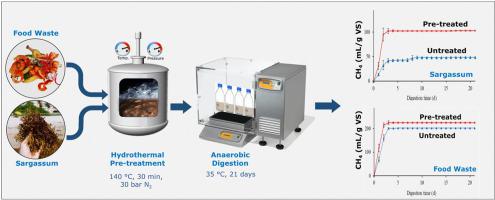Chemosphere ( IF 8.1 ) Pub Date : 2021-02-20 , DOI: 10.1016/j.chemosphere.2021.130035 Terrell M Thompson 1 , Brent R Young 1 , Saeid Baroutian 1

|
The recurring inundation of beaches in the tropical North Atlantic by pelagic Sargassum and the associated social, ecological and economic challenges, have aroused great interest in its potential use as a marine energy crop. However, to date, the seasonal availability and low experimental methane potential of these invasive brown seaweeds have hindered their commercial exploitation as feedstock for sustainable energy production. This novel study evaluated Caribbean pelagic Sargassum and the synergistic interactions of hydrothermal pretreatment and co-digestion with food waste at different mixture ratios, on biogas production enhancement and bio-fertiliser recovery. Batch testing revealed that hydrothermal pretreatment promoted the hydrolysis of organics in pelagic Sargassum and food waste, thus increasing methane recovery from mono-substrate digestion by 212.57% and 10.16%, respectively, in comparison to the untreated samples. Co-digestion of pelagic Sargassum and food waste redistributed metal elements and raised the buffering capacity of the digester, facilitating high organic loadings without pH control. Food waste also provided lipids to the seaweed feed which augmented the digestion performance. The maximum cumulative methane yield of 292.18 ± 8.70 mL/gVS was obtained from a blend of co-pretreated pelagic Sargassum and food waste at the weight ratio 25:75. Screening of the whole digestate from co-digestion indicated bio-fertiliser potential. However, the solid fraction necessitates arsenic remediation to meet international soil standard guidelines. The findings of this study are promising and suggest opportunity for the design, scale up and optimisation of biogas systems, equipped with hydrothermal pretreatment for utilisation of Sargassum seaweeds during influx.
中文翻译:

利用水热预处理和食物垃圾厌氧共消化提高加勒比远洋马尾藻的沼气产量
北大西洋热带海滩经常被中上层马尾藻淹没,以及相关的社会、生态和经济挑战,引起了人们对其作为海洋能源作物的潜在用途的极大兴趣。然而,迄今为止,这些入侵性褐海藻的季节性可用性和较低的实验甲烷潜力阻碍了它们作为可持续能源生产原料的商业开发。这项新颖的研究评估了加勒比远洋马尾藻以及水热预处理和与食物垃圾以不同混合比例共消化的协同相互作用,以提高沼气产量和回收生物肥料。批量测试表明,水热预处理促进了远洋马尾藻和食物垃圾中有机物的水解,从而使单一底物消化的甲烷回收率与未经处理的样品相比分别提高了212.57%和10.16%。中上层马尾藻和食物垃圾的共同消化重新分配了金属元素,提高了消化器的缓冲能力,无需控制 pH 值即可实现高有机负荷。食物垃圾还为海藻饲料提供了脂质,从而增强了消化性能。经共预处理的中上层海藻和食物垃圾以 25:75 的重量比混合,获得的最大累积甲烷产量为 292.18 ± 8.70 mL/gVS。从共消化中筛选整个消化物表明了生物肥料的潜力。然而,固体部分需要进行砷修复才能满足国际土壤标准指南。 这项研究的结果很有希望,并为沼气系统的设计、规模化和优化提供了机会,该沼气系统配备了水热预处理,可在流入期间利用马尾藻海藻。











































 京公网安备 11010802027423号
京公网安备 11010802027423号